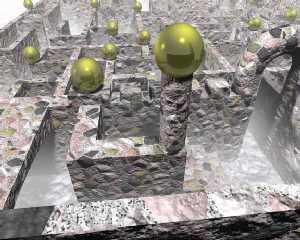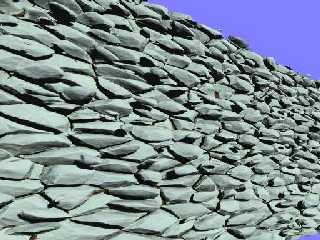 |
 |
|
 |
|
 |
|  |
|  |
|
 |
|
 |
|  |
|  |
|
 |
Here's a scene demoing a rock wall texture using MegaPOV. (Code below....)
It isn't perfect - note the horizontal surface in the foreground - but it
works pretty well on most surfaces.
There is room for improvement; in particular, instead of one basic rock in a
lot of colors, -some of which end up looking a little like that colored
concrete that was fashionable in 1960's suburbia- one could use "blotches"
(or "crackle solid") with a pigment_map with four or five well-defined
stone types at /*A*/.
Spider - you can consider this as a response to your "favorite texture"
question!
-Robert Dawson
#declare RoughStone = texture{
pigment{crackle pigment_map
{[0.08 granite scale 0.2 color_map
{[0.5 rgb 0.8]
[0.8 rgb 0.2]
}]
[0.08 average pigment_map /*A*/
{[0.2 granite]
[0.8 blotches color_map
{[0.0 rgb 1]
[0.7 rgb <0.8,0.6,0.6>]
[0.8 rgb <0.8,0.75,0.5>]
[0.9 rgb 0.3]
}]
} ] }
}
normal {average normal_map {
[ 0.6 crackle 2 slope_map
{[0.0 <0,0>]
[0.08 <0,0>]
[0.08 <0,1>]
[0.7 <1,0>]
}]
[0.4 granite 1.5 ]}
}
finish { ambient 0.05 diffuse 0.95}
}
Post a reply to this message
Attachments:
Download 'Blocky.jpg' (49 KB)
Preview of image 'Blocky.jpg'

|
 |
|  |
|  |
|
 |
|
 |
|  |
|  |
|
 |
Robert Dawson wrote:
>
> Here's a scene demoing a rock wall texture using MegaPOV. (Code
> below....)
> It isn't perfect - note the horizontal surface in the foreground - but
> it
> works pretty well on most surfaces.
> There is room for improvement; in particular, instead of one basic
> rock in a
> lot of colors, -some of which end up looking a little like that
> colored
> concrete that was fashionable in 1960's suburbia- one could use
> "blotches"
> (or "crackle solid") with a pigment_map with four or five
> well-defined
> stone types at /*A*/.
>
> Spider - you can consider this as a response to your "favorite
> texture"
> question!
>
> -Robert Dawson
>
> #declare RoughStone = texture{
>
> pigment{crackle pigment_map
> {[0.08 granite scale 0.2 color_map
> {[0.5 rgb 0.8]
> [0.8 rgb 0.2]
> }]
> [0.08 average pigment_map /*A*/
> {[0.2 granite]
> [0.8 blotches color_map
> {[0.0 rgb 1]
> [0.7 rgb <0.8,0.6,0.6>]
> [0.8 rgb <0.8,0.75,0.5>]
> [0.9 rgb 0.3]
> }]
> } ] }
> }
>
> normal {average normal_map {
> [ 0.6 crackle 2 slope_map
> {[0.0 <0,0>]
> [0.08 <0,0>]
> [0.08 <0,1>]
> [0.7 <1,0>]
>
> }]
> [0.4 granite 1.5 ]}
> }
> finish { ambient 0.05 diffuse 0.95}
> }
>
> [Image]
I don't know about the rock texture (the edges seem too sharp) but I
like the scene. Perhaps a bit too bright. I'd like to see it from other
POVs.
Remco
Post a reply to this message
|
 |
|  |
|  |
|
 |
|
 |
|  |
|  |
|
 |
Or you could use a isosurface...
This is just a simple crackle pigment_map, as you can see it needs some
fixing, since some of the stones are not even attached to the wall 8-)
Post a reply to this message
Attachments:
Download 'WallTexture.jpg' (44 KB)
Preview of image 'WallTexture.jpg'

|
 |
|  |
|  |
|
 |
|
 |
|  |
|  |
|
 |
In article <387e33e4@news.povray.org>, "Bill DeWitt"
<the### [at] earthlink net> wrote:
> This is just a simple crackle pigment_map, as you can see it needs some
> fixing, since some of the stones are not even attached to the wall 8-)
This can be fixed by leaving one dimension out, like func(x, y, 0).
Unfortunately this makes it behave like a height field, the bumps only
go in and out with no sideways bumps. This might be corrected by using
noise3d or another pigment function.
--
Chris Huff
e-mail: chr### [at] yahoo net> wrote:
> This is just a simple crackle pigment_map, as you can see it needs some
> fixing, since some of the stones are not even attached to the wall 8-)
This can be fixed by leaving one dimension out, like func(x, y, 0).
Unfortunately this makes it behave like a height field, the bumps only
go in and out with no sideways bumps. This might be corrected by using
noise3d or another pigment function.
--
Chris Huff
e-mail: chr### [at] yahoo com
Web page: http://chrishuff.dhs.org/ com
Web page: http://chrishuff.dhs.org/
Post a reply to this message
|
 |
|  |
|  |
|
 |
|
 |
|  |
|  |
|
 |
I meant to include the relevant portion of the file...
/// Begin
#declare Wall = function { pigment { Stones } }
isosurface { function ( z-Wall(x,y,z)*0.1)
sign 1 eval
accuracy .005
texture { pigment { Stones2 } }
scale < 3.0, 1.0, 1.0 >
}
/// End
"Chris Huff" <chr### [at] yahoo com> wrote :
>
> This can be fixed by leaving one dimension out, like func(x, y, 0).
>
I'll see what that does... com> wrote :
>
> This can be fixed by leaving one dimension out, like func(x, y, 0).
>
I'll see what that does...
Post a reply to this message
|
 |
|  |
|  |
|
 |
|
 |
|  |
|  |
|
 |
I guess what we need now is a normal-displacement patch of some sort.
--
Homepage: http://www.faricy.net/~davidf/
___ ______________________________
| \ |_ <dav### [at] faricy net>
|_/avid |ontaine <ICQ 55354965> net>
|_/avid |ontaine <ICQ 55354965>
Post a reply to this message
|
 |
|  |
|  |
|
 |
|
 |
|  |
|  |
|
 |
In article <387E69D8.B13E277D@faricy.net>, dav### [at] faricy net says...
> I guess what we need now is a normal-displacement patch of some sort.
YES!!! PLEASE? This is what I was asking about in my post to
unofficial.patches. Stumbling around with the ISOsurface functions
trying to match the shape of my CSG object is frustrating, to say the
least. Being able to apply random bumps to a normal that actually
displace the object would be much easier for me to use.
Rich net says...
> I guess what we need now is a normal-displacement patch of some sort.
YES!!! PLEASE? This is what I was asking about in my post to
unofficial.patches. Stumbling around with the ISOsurface functions
trying to match the shape of my CSG object is frustrating, to say the
least. Being able to apply random bumps to a normal that actually
displace the object would be much easier for me to use.
Rich
Post a reply to this message
|
 |
|  |
|  |
|
 |
|
 |
|  |
|  |
|
 |
>Or you could use a isosurface...
That wall looks real if it wasant for the odd stone
hovering just outside the wall.
--
Cheers
Steve email mailto:sjl### [at] ndirect co co uk
%HAV-A-NICEDAY Error not enough coffee 0 pps.
web http://www.ndirect.co.uk/~sjlen/
or http://start.at/zero-pps uk
%HAV-A-NICEDAY Error not enough coffee 0 pps.
web http://www.ndirect.co.uk/~sjlen/
or http://start.at/zero-pps
Post a reply to this message
|
 |
|  |
|  |
|
 |
|
 |
|  |




![]()